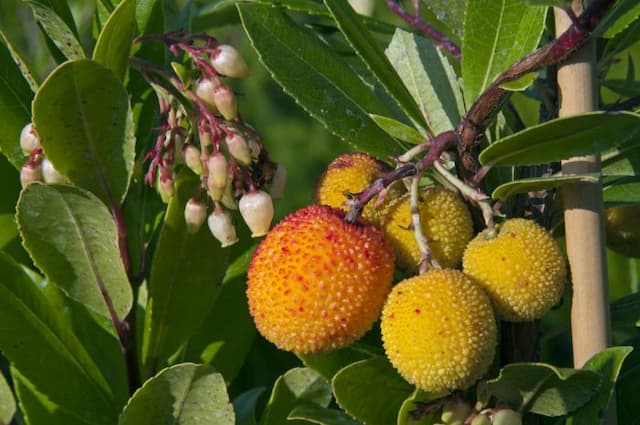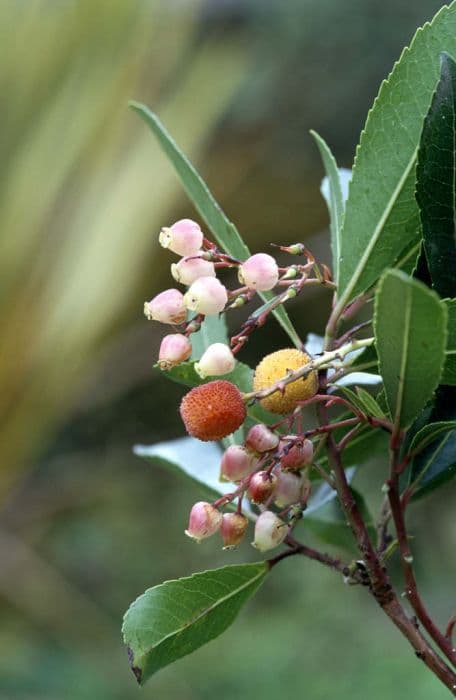White Heath Erica mammosa white-flowered

ABOUT
The Erica mammosa white-flowered, commonly known as the Nine-angled Heath, is admired for its distinctive white blooms. The flowers are shaped like urns or little bells, clustered densely together, creating a striking contrast with the dark green foliage. Each flower is composed of a small tubular corolla that flares open at the mouth, with tiny protruding stamens that are often lightly colored, adding to the delicate appearance of the bloom. The plant has needle-like leaves that are fine and closely set along the stems, forming a textured and bushy appearance. These leaves can have a somewhat whorled arrangement, contributing to the plant's dense and feathery look. The foliage often shows off a bright to dark green shade, which beautifully complements the purity of the white flowers. The overall appearance of the Nine-angled Heath is that of a lush, evergreen shrub that has a profuse and elegant flowering habit, making it a true spectacle when in full bloom. Its unique flower structure and coloration provide a point of interest in gardens and natural settings, lending a touch of winter wonderland allure when many other plants have ceased to bloom.
About this plant
 Names
NamesFamily
Ericaceae
Synonyms
White Milkwood, Nine-Pins, Ninnypins
Common names
Erica mammosa white-flowered.
 Toxicity
ToxicityTo humans
Information regarding the specific toxicity of the Ninepin Heath, the common name for Erica mammosa white-flowered, to humans is not widely documented in standard horticultural or toxicological references. Therefore, it's important to treat this plant with caution. If a plant is not well-studied for its effects on humans, it is generally advisable to prevent ingestion and avoid contact with sap if you have sensitive skin. In general, if any part of an unfamiliar plant is ingested, it's wise to consult a medical professional or poison control center, as they can offer guidance based on the most up-to-date and region-specific information.
To pets
Information on the toxicity of Ninepin Heath (Erica mammosa white-flowered) to pets is also not widely available. Lack of documented evidence does not guarantee safety, and it is best to keep pets from ingesting or coming into prolonged contact with plants that haven't been confirmed as non-toxic. If your pet ingests part of this plant, monitor for any unusual behavior and consult with your veterinarian for personalized advice for your pet's health and safety. Common symptoms of plant poisoning in pets can include vomiting, diarrhea, drooling, lethargy, and lack of appetite. If you notice these signs, seek veterinary assistance promptly.
 Characteristics
CharacteristicsLife cycle
Perennials
Foliage type
Evergreen
Color of leaves
Green
Flower color
White
Height
6 feet [1.8 meters]
Spread
3 feet [0.9 meters]
Plant type
Shrub
Hardiness zones
9
Native area
South Africa
Benefits
 General Benefits
General Benefits- Landscape Aesthetics: Adds visual interest to gardens with its white flowers and evergreen foliage.
- Habitat Support: Offers nectar for pollinators like bees and attracts various insects which in turn provide food for birds.
- Drought Tolerance: Adapted to survive in low-water conditions, making it suitable for xeriscaping.
- Soil Erosion Control: Helps prevent soil erosion due to its root system which holds soil in place.
- Low Maintenance: Requires minimal care once established, which is convenient for gardeners seeking less labor-intensive plants.
- Year-Round Interest: Provides color and texture in the garden throughout the year, with evergreen leaves and seasonal blooms.
- Adaptability: Can grow in a variety of soil types, although it prefers acidic conditions.
 Medical Properties
Medical PropertiesThis plant is not used for medical purposes.
 Air-purifying Qualities
Air-purifying QualitiesThis plant is not specifically known for air purifying qualities.
 Other Uses
Other Uses- As a Natural Dye: The blooms of the white-flowered Erica can be used to extract natural pigments for fabric dyeing.
- Floral Arrangements: The long-lasting flowers and distinctive foliage of this Erica make it suitable for inclusion in bouquets and floral displays.
- Winter Garden Interest: The plant blooms in winter, providing a splash of color when most other plants are dormant.
- Bonsai Cultivation: Due to its compact size and attractive shape, it can be grown as a bonsai specimen.
- Erosion Control: This Erica can be used in landscaping for slope stabilization and erosion control because of its rooting habit.
- Garden Borders: It is often used to create low, dense borders or edges in garden beds and pathways.
- Wildlife Habitat: The dense foliage offers shelter and nesting opportunities for various birds and insects.
- Photography Subject: With its striking white flowers, it is a popular subject for botanical photographers and plant enthusiasts.
- Themed Gardens: It can be included in "Winter Wonderland" themed gardens due to its blooming time and color.
- Artistic Inspiration: Some artists use the plant's form and flowers as inspiration for botanical illustrations and paintings.
Interesting Facts
 Feng Shui
Feng ShuiThe Erica mammosa white-flowered, commonly known as white-flowered heath, is not used in Feng Shui practice.
 Zodiac Sign Compitability
Zodiac Sign CompitabilityThe white-flowered heath is not used in astrology practice.
 Plant Symbolism
Plant Symbolism- Rarity and Unique Beauty: The white flowers of Erica mammosa, commonly known as Nodding Heath, symbolize rarity and unique beauty as the color white often stands for purity and the unusual nodding feature of the flowers adds a unique aesthetic attribute.
- Protection and Good Fortune: In plant symbolism, heaths are sometimes associated with protection and bringing good fortune, which could extend to the Nodding Heath, offering a feeling of safety and the promise of good things to come.
- Adaptability and Resilience: As Erica species are known for thriving in harsh conditions, the white-flowered Erica mammosa represents adaptability and resilience, signifying the ability to endure and flourish despite challenges.
- Tranquility and Peace: The color white is also emblematic of tranquility and peace, so the white blooms of the Nodding Heath can be seen as a symbol of calmness and the soothing of emotions.
- Solitude and Contemplation: Heaths often grow in less crowded areas, which allows them to symbolize solitude and contemplation, reflecting a space or time for personal reflection and growth.
 Water
WaterThe Ninepin Heath needs regular watering to maintain moist soil, especially during its growing season in spring and summer. It's best to water this plant about once a week, providing enough water to soak the soil thoroughly, which could be around 1-2 gallons depending on the size of the plant and the environmental conditions. In the cooler months, you can reduce watering to every other week. Always check the top couple of inches of soil for dryness before watering again. Avoid over-watering, as it can lead to root rot in these plants.
 Light
LightNinepin Heath thrives in bright, indirect light but can also tolerate partial shade. To ensure the plant gets the best light conditions, place it in a spot where it will receive a good amount of morning sunlight but is protected from the harsh afternoon sun. An east-facing window or a location that receives filtered light would be ideal.
 Temperature
TemperatureNinepin Heath prefers moderate temperatures and reacts best within the range of 50 to 70 degrees Fahrenheit. Make sure to protect your Ninepin Heath from temperatures below 40 degrees Fahrenheit to prevent cold damage. The ideal conditions for Ninepin Heath include ensuring the plant is kept in a location where it doesn't experience extreme temperature fluctuations or drafts.
 Pruning
PruningPruning Ninepin Heath is important to maintain its shape and encourage bushy growth. The best time to prune is in late winter or early spring before new growth begins. Prune lightly, removing dead or overgrown branches, to help the plant produce more flowers. Pruning can be done annually or as needed when you notice parts of the plant becoming too leggy or unkempt.
 Cleaning
CleaningAs needed
 Soil
SoilThe Ninepin Heath (Erica mammosa) thrives best in a well-draining, acidic soil mix with a pH of 4.5 to 5.5. A suitable mix can be made of equal parts peat, coarse sand or perlite, and pine bark fines. Ensure the mix allows for good aeration and moisture retention while avoiding waterlogged conditions.
 Repotting
RepottingNinepin Heath should be repotted every two to three years to refresh the soil and to accommodate root growth. The best time for repotting is in the spring, just before the active growing season begins.
 Humidity & Misting
Humidity & MistingNinepin Heath prefers moderate to high humidity levels. Aim to maintain humidity around 50-60% for optimal growth conditions, as too low humidity can lead to desiccation and leaf browning.
 Suitable locations
Suitable locationsIndoor
Place Ninepin Heath in acidic soil, bright, indirect light.
Outdoor
Plant Ninepin Heath in acidic soil, partial sun, shelter from harsh wind.
Hardiness zone
7-9 USDA
 Life cycle
Life cycleErica mammosa, commonly known as the Nine-pin Heath, begins its life cycle from seed, with germination reliant on specific conditions, which often include fire or exposure to smoke, a common ecological trigger in its native fynbos habitat. Once germinated, the seedling grows slowly, establishing a root system and developing into a juvenile plant. As it matures, the Nine-pin Heath forms a woody stem and needle-like leaves, adapted to its dry environment. It reaches reproductive maturity after several years, producing distinctive white flowers that attract pollinators such as bees and birds, leading to pollination and seed development. Seeds are dispersed naturally, sometimes by wind or animal movement, completing the reproductive cycle. Throughout its life, the Nine-pin Heath may experience cycles of growth and flowering, typically blooming in its natural habitat during late winter to spring.
 Propogation
PropogationPropogation time
Spring-Early Summer
Propogation: The most popular method of propagating the Erica mammosa, commonly known as the white-flowered heath, is through cuttings. This technique is often carried out in the late summer or early fall when the plant’s growth has slowed. Healthy, non-flowering shoots are selected and cut into 2 to 3-inch (5 to 7.5 cm) lengths. The cuttings should have a few leaves left at the top and the lower leaves are removed. The base of the cutting is then dipped in a rooting hormone to encourage root development. The prepared cuttings are inserted into a mix of peat and perlite or sand, given enough moisture, and placed in a warm, bright environment, but not in direct sunlight. To maintain high humidity, the cuttings can be covered with a clear plastic bag or placed in a propagator until roots develop, which generally takes several weeks.









